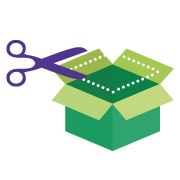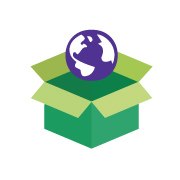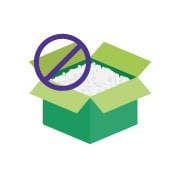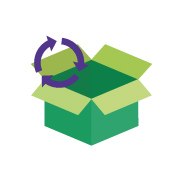SMASH Packaging Progress
Our four-year SMASH Packaging Plan is our approach to drive improvement in the sustainability of our packaging.
Below is an update on our 2021 actions and results. You can also download a copy of our 2021 Annual Update.
The following system is used to provide a qualitative status of our progress toward each of our 2022 targets:
Not Started | On Track | Focus Required | Off Track | Achieved

Shrink – Reduce Amount of Packaging
Our aim is to eliminate the use of packaging that is excessive in size or weight which unnecessarily consumes more resources, increases energy use and air emissions during transportation. Excess packaging is also undesirable for our customers since there are costs associated with the management and disposal of the packaging.
New product packaging aligned with our standards for weight and volume (Focus Required)
- In 2021, we continued to increase collaboration with our product development teams in order to minimize the amount of packaging for our new products.
20 key improvement projects for existing packaging (On Track)
- 15 product and distribution packaging improvement projects resulting in a total annual reduction of 250+ metric tons of corrugated and plastic packaging.
- In 2021, we implemented a new bulk packaging solution for a subset of our Durapore® and Millipore Express® filter cartridges, that allows us to reduce the amount of corrugated packaging by 47 to 71% per unit depending on the reference. This also helps reduce 50% of the time required to open and dispose of the packaging.
- In 2021, we optimized the product box used for our NovaSeptum® Sterile Sampling Systems resulting in an annual reduction of 13 metric tons of corrugated packaging.
- In 2021, we optimized the thickness of the plastic air pillows used at one of our distribution centers in Europe, resulting in an annual reduction of 11 metric tons of plastic packaging.
- In 2021, we initiated a pilot project at three of our main U.S. distribution centers to eliminate the use of transparent plastic envelopes that store packing slips on the outside of shipping boxes. Once we implement this practice globally, it would save 20 metric tons of plastic per year.
20% reduction of air space in distribution boxes (Focus Required)
- In 2021, we developed a plan to identify and prioritize opportunities to reduce air space in distribution boxes. A questionnaire was distributed to a selection of distribution centers across our organization. The analysis of the information gathered will contribute to the determination of the improvement methodology and the KPI to measure and track progress, with an implementation planned for the second half of 2022.
- In 2021, we completed the development and validation of packaging solutions that meet performance requirements and transit safety regulations while minimizing packaging for the shipment of small products from two of our major distribution centers in the U.S. and in Europe. These new packaging solutions will result in about 50% air space reduction for 1,150+ shipments daily, leading to a reduction of 65 metric tons of packaging materials annually. We continued to work on similar projects at other distribution centers in Europe and Asia to reduce more air space and packaging material consumption.

Secure – Achieve Zero Deforestation
Deforestation is a significant source of global warming and is a threat to biodiversity. Our aim is to ensure that the wood and fiber-based packaging materials that we use do not contribute to deforestation.
New product packaging aligned with our zero deforestation standards (Focus Required)
- In 2021, we continued to increase collaboration with our product development teams in order to foster usage of certified and/or recycled content for new wood and fiber-based product packaging.
- In parallel of adding sustainable forestry certification as a requirement for any new packaging development, our Lab Water Solutions unit went further in 2021 with the addition of sustainable forestry certification for the boxes of the recently launched Milli-Q® IQ, IX and EQ series water purification systems as well as the Q-POD® and E-POD® water remote dispensers, for a total of about 30 metric tons of corrugated materials.
90% of existing packaging aligned with our zero deforestation standards (On Track)
100% of packaging from deforestation-risk countries certified sustainably sourced (On Track)
- Annual deforestation assessment conducted among our main wood- and fiber-based packaging suppliers who represent 98% of our total direct spend to assess sourcing practices, the sustainability characteristics of our packaging materials, and identify opportunities for improvement.
- In 2021, 71.5% of the materials sourced directly for packing and shipping products are currently aligned with our zero deforestation standards. It represents an 8% increase from 2019.
- In 2021, we completed the addition of sustainable forestry certification for a total of 800+ metric tons of corrugated and paperboard thanks to the progress of conversion projects with some of our key European, Chinese, and South Korean vendors.

Switch – Improve Plastic Sustainability
Conventional plastic packaging has several sustainability issues associated with it. Our aim is to improve sustainability of plastic materials used in packaging applications, including increasing the use of materials with lower environmental impacts and reducing the use of plastics produced with chemicals of concern.
New product packaging aligned with our plastic sustainability standards (Focus Required)
- In 2021, we continued to increase collaboration with our product development teams in order to optimize sustainability characteristics of new products' plastic packaging components.
20 improvement projects to replace existing plastic packaging by more sustainable solutions (On Track)
- 10 product packaging improvement projects and distribution packaging improvement initiatives with projects at multiple locations.
- In 2021, we completed the validation of the use of amorphous polyethylene terephthalate-polyethylene (APET-PE) instead of polyvinylchloride (PVC) for the thermoformed protective plastic trays used for Sterility Media & Fluids Pharma produced at one our sites in Europe. This change will avoid the use of about 20 metric tons of PVC which is manufactured using the vinyl chloride monomer which is a carcinogen, and that releases dioxins and furans at end of life that are toxic and affect recyclability.
- In 2021, we implemented recycled PET instead of virgin PET for the plastic covers used for our 10L, 30L, and 200L returnable containers filled in Europe.
- In 2021, we replaced the use of foam chips for distribution package filling by crumple paper made of 100% recycled content at one of our distribution centers in Europe, resulting in the avoidance of 23 metric tons of foam chips.
- Our Lab Water Solutions unit improved the protective foam of recently launched Milli-Q® IQ, IX and EQ series water purification systems as well as the Q-POD® and E-POD® water remote dispensers. The systems’ protective inserts are now made of 100% bio-based polyethylene (PE) foam from sugar cane waste, and the PODs protective inserts are now made of PE foam with a minimum of 50% recycled content.
20% reduction of Expanded Polystyrene (EPS) (Focus Required)
- Continuous efforts to replace EPS inserts with molded pulp inserts for the shipment of our glass reagent bottles, resulting in the use of about 3 million molded pulp inserts in 2021.
- In 2021, we faced some technical and sourcing challenges for some of our new pulp designs under development but we completed the validation of a new pulp design for our individual 4L glass bottles produced in Europe.
- In 2021, we completed the characteristics and requirement analysis of our insulated shipping containers used in our main U.S. sites to define a comprehensive validation plan for our new greener coolers. We also completed a distribution channel analysis where we studied our delivery times and distances to test accurately for real-world scenarios. We expect to see a greener cooler rollout at our major US distribution centers by the end of 2022 resulting in a reduction of 60+ metric tons of EPS which represents a volume of 5,000+ m3 of EPS, enough to fill more than 7 jumbo jets.

Save – Maximize Recycling
Our aim is to maximize recycling of our packaging materials by eliminating the use of packaging materials that are not compatible with recycling and by providing our customers with recycling guidance for all our packaging materials.
New product packaging aligned with our standards for recyclability (Focus Required)
- In 2021, we continued to increase collaboration with our product development teams in order to optimize recyclability of new products packaging.
100% of fiber-based packaging not compatible with recycling (On Track)
- In 2021, we completed the validation of the replacement of non-recyclable edge protectors used at one of our European sites by 100% paper-based alternative resulting in an annual reduction of 70 metric tons of non-recyclable edge protectors.
- We continued to work on a project aiming at eliminating a specific coating used on some of our product boxes at one of our U.S. sites. We expect to identify a suitable solution to replace this coating by the end of 2022, resulting in an annual reduction of 50 metric tons of non-recyclable boxes.
- We implemented a new process for the reuse of wood pallets for the delivery of raw materials to our main site in Europe, resulting in the elimination of 1,000 metric tons of wood pallets sourced annually.
100% of products with packaging recycling/disposal guidance (Focus Required)
- In 2021, we continued to develop our global packaging recycling guidance approach to define and systematically communicate this information to our customers for all our products. We expect a roll-out of the first version of this solution by the end of 2022.
To continue reading please sign in or create an account.
Don't Have An Account?